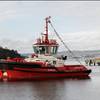St. Lawrence Seaway June Cargoes See Modest Rise
The St. Lawrence Seaway reported that year-to-date total cargo shipments for the period March 22 to June 30 were 13.2 million metric tons, up 1.3 percent over the same period in 2011.
Iron ore and coal used in the steel and construction industries remained the dominant story in tonnage numbers along the St. Lawrence Seaway System. Iron ore shipments through the Seaway rose 34 percent to 1.4 million metric tons in June. Year-to-date figures for iron ore were up 27 percent to 3.8 million metric tons. Coal shipments for power generation and steel production rose to 1.8 million metric tons – a 30 percent hike over 2011. Grain shipments were down for the second straight month due to drought conditions in the U.S. June saw a 16 percent downturn for all grain in 2012 versus the same time last year.
General cargo such as wind turbine components posted a 163 percent jump in June compared to the same month last year. “The Seaway continues to show its global relevance as a vital marine route moving high value wind components worldwide,” said Rebecca Spruill, director of trade development for the Saint Lawrence Seaway Development Corporation. “We anticipate that trend to continue, especially in light of the pending tax credit deadline set to expire at the end of the year.”
The Port of Duluth has become a strategic link in the global wind energy supply chain, shipping 60 wind turbine blades manufactured in North Dakota for export to Brazil. Jonathan Lamb, vice president and general manager at Lake Superior Warehousing Co., the breakbulk terminal operator at the port, said: “This shipment is one of nearly 20 energy-related cargoes on the books for 2012 and our second shipment of blades from North Dakota to Brazil in recent years. Duluth has moved well over a million freight tons of wind turbine components from and to Europe and South America since the port first started handling wind turbines in 2005.”
According to Adolph Ojard, Duluth Seaway Port Authority executive director, “The expertise of Lake Superior Warehousing and our joint commitment to streamlining project cargo handling makes this terminal very attractive to major manufacturers and logistics experts worldwide who consider the Port of Duluth an ideal gateway in and out of the North American heartland.”
The construction industry was the main story at the Port of Green Bay. Year-to-date cement tonnage at the port was up 62 percent over last year. “The reconstruction of Highway 41, renovations at Lambeau Field, and other road construction projects pushed up the quantities of cement and liquid asphalt that moved through the port,” said Dean Haen, port manager. “In addition, one of our largest port tenants, US Venture, continues to grow its petroleum products import and export business, and is already 18 percent ahead of last year.”
The Great Lakes-St. Lawrence Seaway maritime industry supports 227,000 jobs in the U.S. and Canada, and annually generates $14.1 billion in salary and wages, $33.5 billion in business revenue, and $4.6 billion in federal, state/provincial and local taxes. North American farmers, steel producers, construction firms, food manufacturers, and power generators depend on the 164 million metric tons of essential raw materials and finished products that are moved annually on the system. This vital trade corridor saves companies $3.6 billion per year in transportation costs compared to the next least-costly land-based alternative.














